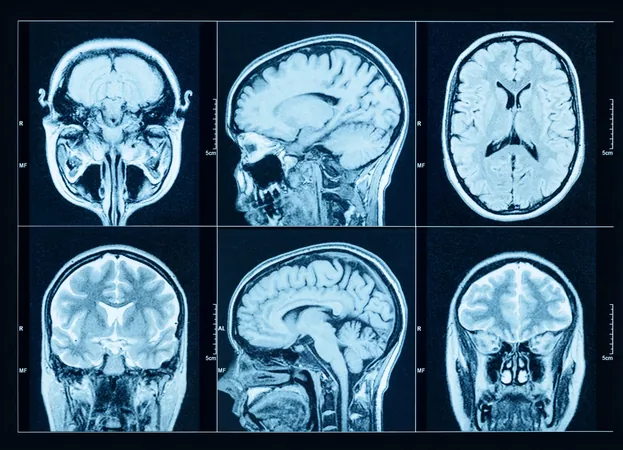
Revolutionary Brain Imaging Techniques: The Future of Parkinson’s Disease Diagnosis
2025-08-19
Author: Ming
Unlocking the Mysteries of Parkinson’s Disease
Parkinson’s disease (PD) is more than just a clinical diagnosis; it's a complex neurodegenerative disorder that requires innovative approaches for accurate detection. While diagnosis traditionally hinges on clinical examinations, a range of advanced imaging techniques is emerging as powerful allies in the fight against this debilitating condition.
The Game-Changer: Dopamine Transporter Scan (DaTscan)
At the forefront is the Dopamine Transporter Scan—or DaTscan—a groundbreaking imaging test. This method involves injecting a radioactive tracer known as Ioflupane into the bloodstream, which then travels to the brain and targets dopamine transporters. The results reveal a diminished signal in the striatum, a brain region crucial for motor control, indicating potential PD.
Exploring Other Advanced Imaging Techniques
While DaTscan is a staple, a multitude of imaging tests is evolving to offer deeper insights into PD. Each technique has its unique advantages and drawbacks, and while some are still confined to research, others are making their way into clinical practice.
MRI: Can It Detect Parkinson’s?
Traditional MRI scans don’t directly diagnose PD; however, advanced techniques like Neuromelanin-sensitive MRI and Iron-sensitive MRI are showing promising results. These specialized methods can reveal significant brain changes associated with PD, providing valuable diagnostic information.
FDG-PET: A Metabolic Perspective
Fluorodeoxyglucose Positron Emission Tomography (FDG-PET) measures glucose metabolism across the brain, highlighting areas affected by PD. Research indicates that PD patients show distinct metabolic patterns compared to healthy individuals, making FDG-PET a critical tool for early diagnosis.
F-DOPA PET: Visualizing Dopamine Functionality
Another cutting-edge option, F-DOPA PET, uses a radiolabeled form of the amino acid L-DOPA to image dopamine-producing cells. Patients with PD exhibit reduced F-DOPA uptake in the striatum, especially on the side opposite from where first symptoms appear, thus offering a precise gauge of dopaminergic neuron loss.
Innovative NM-MRI Techniques
Neuromelanin-sensitive MRI identifies dopamine neuron health by detecting the neuromelanin pigment. Studies showcase its ability to distinguish PD patients with remarkable accuracy, hinting at its future role as a non-invasive diagnostic tool without radiation exposure.
Iron-Sensitive MRI: The Iron Connection
Quantitative Susceptibility Mapping (QSM) is another promising technique that maps iron deposits in the brain. Elevated iron levels in the substantia nigra correlate with PD severity, offering a compelling diagnostic avenue.
Transcranial Sonography: A Low-Cost Alternative
Utilizing ultrasound, Transcranial Sonography (TCS) stands out as a cost-effective method to visualize the substantia nigra. Recent studies indicate it can differentiate PD from healthy controls with impressive accuracy.
The Future: Alpha-Synuclein Imaging
The pathologic hallmark of PD is the accumulation of alpha-synuclein protein. Emerging imaging agents are under development to detect these aggregates, potentially paving the way for earlier and more definitive diagnoses.
The Power of Combining Imaging Techniques
The real magic may lie in combining various imaging methods. For instance, pairing F-DOPA PET with MRI can reveal dopamine loss with anatomical precision, while combining FDG-PET with Diffusion Tensor Imaging could elucidate structural and functional brain changes.
Taking Action: What You Need to Know
As this landscape of imaging technology continues to evolve, it's critical for patients and healthcare providers to stay informed. Advanced techniques like NM-MRI and QSM appear promising, offering a non-invasive approach to PD diagnosis. Meanwhile, TCS provides accessible options for early screening.
With the horizon brightening for alpha-synuclein imaging, individuals diagnosed with PD may soon benefit from definitive and timely interventions. Empowering doctors with these comprehensive tools will bring us closer to understanding and effectively treating Parkinson's disease.

 Brasil (PT)
Brasil (PT)
 Canada (EN)
Canada (EN)
 Chile (ES)
Chile (ES)
 Česko (CS)
Česko (CS)
 대한민국 (KO)
대한민국 (KO)
 España (ES)
España (ES)
 France (FR)
France (FR)
 Hong Kong (EN)
Hong Kong (EN)
 Italia (IT)
Italia (IT)
 日本 (JA)
日本 (JA)
 Magyarország (HU)
Magyarország (HU)
 Norge (NO)
Norge (NO)
 Polska (PL)
Polska (PL)
 Schweiz (DE)
Schweiz (DE)
 Singapore (EN)
Singapore (EN)
 Sverige (SV)
Sverige (SV)
 Suomi (FI)
Suomi (FI)
 Türkiye (TR)
Türkiye (TR)
 الإمارات العربية المتحدة (AR)
الإمارات العربية المتحدة (AR)